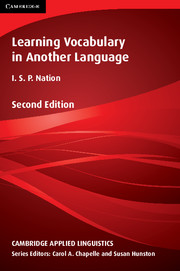Book contents
- Frontmatter
- Contents
- Series editors' preface
- Acknowledgements
- Introduction
- 1 The goals of vocabulary learning
- 2 Knowing a word
- 3 Teaching and explaining vocabulary
- 4 Vocabulary and listening and speaking
- 5 Vocabulary and reading and writing
- 6 Specialised uses of vocabulary
- 7 Vocabulary-learning strategies
- 8 Learning words from context
- 9 Word parts
- 10 Using dictionaries
- 11 Deliberate learning from word cards
- 12 Finding and learning multiword units
- 13 Testing vocabulary knowledge and use
- 14 Designing the vocabulary component of a language course
- Appendices
- Subject index
- Author index
6 - Specialised uses of vocabulary
Published online by Cambridge University Press: 15 February 2018
- Frontmatter
- Contents
- Series editors' preface
- Acknowledgements
- Introduction
- 1 The goals of vocabulary learning
- 2 Knowing a word
- 3 Teaching and explaining vocabulary
- 4 Vocabulary and listening and speaking
- 5 Vocabulary and reading and writing
- 6 Specialised uses of vocabulary
- 7 Vocabulary-learning strategies
- 8 Learning words from context
- 9 Word parts
- 10 Using dictionaries
- 11 Deliberate learning from word cards
- 12 Finding and learning multiword units
- 13 Testing vocabulary knowledge and use
- 14 Designing the vocabulary component of a language course
- Appendices
- Subject index
- Author index
Summary
When learners have mastered the 2,000–3,000 high-frequency words of general usefulness in English, it is wise to direct vocabulary learning to more specialised areas, depending on the aims of the learners. First, it is possible to specialise by learning the shared vocabulary of several fields of study, for example academic vocabulary. Next the specialised vocabulary of one particular field or part of that field can be studied. Because many courses focus on learners who will do academic study in English, we will look first at academic vocabulary.
What is academic vocabulary?
Academic vocabulary is variously known as ‘generally useful scientific vocabulary’ (Barber, 1962), ‘sub-technical vocabulary’ (Anderson, 1980; Cowan, 1974; Yang, 1986), ‘semi-technical vocabulary’ (Farrell, 1990), ‘specialised non-technical lexis’ (Cohen et al., 1988), ‘frame words’ (Higgins, 1966), and ‘academic vocabulary’ (Coxhead, 2000; Martin, 1976). The division of the vocabulary of academic texts into three levels of general service, or basic vocabulary, sub-technical vocabulary and technical vocabulary, is a commonly made distinction (although it ignores mid-frequency and low-frequency vocabulary which has no technical or sub-technical features). Dresher (1934) made such a three-part distinction when looking at mathematics vocabulary for native speakers. Other writers have independently made a similar distinction. Typically, academic vocabulary lists include words like accumulate, achieve, compound, complex and proportion which are common in academic texts and not so common elsewhere.
- Type
- Chapter
- Information
- Learning Vocabulary in Another Language , pp. 289 - 325Publisher: Cambridge University PressPrint publication year: 2013

